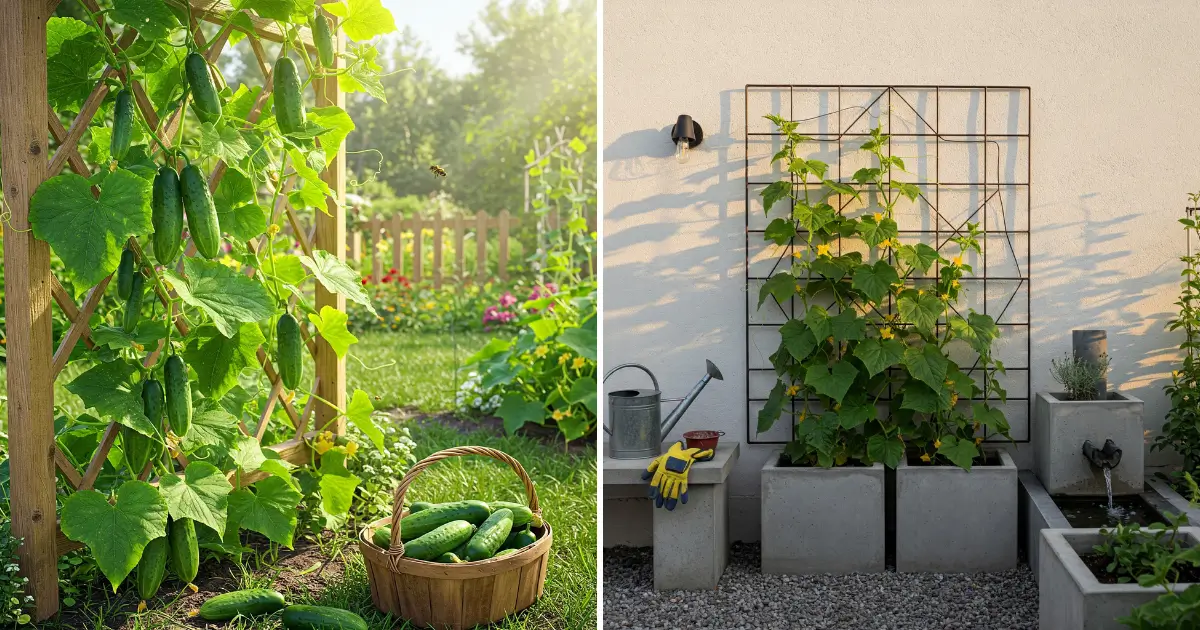Growing cucumbers in your garden can be a rewarding experience, but it often comes with challenges like limited space, pests, and diseases. One effective solution to these problems is building a cucumber trellis.
A trellis not only saves space but also promotes healthier plants and higher yields. In this beginner’s guide, we’ll walk you through everything you need to know about building a cucumber trellis, from the benefits to step-by-step instructions.
Why Use a Cucumber Trellis?
Before diving into the construction process, it’s important to understand why a trellis is beneficial for growing cucumbers:
- Saves Space: Cucumbers are vining plants that can spread out and take up a lot of garden space. A trellis allows them to grow vertically, freeing up ground space for other plants.
- Improves Air Circulation: Growing cucumbers vertically improves airflow around the plants, reducing the risk of fungal diseases like powdery mildew.
- Easier Harvesting: When cucumbers are grown on a trellis, they hang down, making them easier to spot and pick.
- Healthier Plants: Trellised cucumbers are less likely to come into contact with soil-borne pests and diseases.
- Straighter Fruits: Cucumbers grown on a trellis are less likely to curl or become misshapen because they hang freely.
Materials Needed to Build a Cucumber Trellis
Building a cucumber trellis doesn’t require expensive materials. Here’s a list of what you’ll need:
- Wooden stakes or metal posts (6-8 feet tall)
- Garden twine, netting, or wire mesh
- Hammer or mallet
- Nails or screws
- Scissors or wire cutters
- Tape measure
- Optional: Zip ties or clips for securing vines
Step-by-Step Guide to Building a Cucumber Trellis
Step 1: Choose the Right Location
Select a sunny spot in your garden with well-draining soil. Cucumbers need at least 6-8 hours of sunlight daily. Ensure the area is easily accessible for watering and harvesting.
Step 2: Prepare the Ground
Clear the area of weeds and debris. Loosen the soil and amend it with compost or organic matter to provide nutrients for your cucumber plants.
Step 3: Install the Support Posts
Drive the wooden stakes or metal posts into the ground at least 12-18 inches deep to ensure stability. Space them 4-6 feet apart, depending on the length of your trellis. For larger gardens, you can create multiple rows.
Step 4: Attach the Trellis Material
- For String Trellis: Tie garden twine horizontally and vertically between the posts to create a grid pattern. Ensure the strings are taut to support the weight of the vines.
- For Netting or Wire Mesh: Stretch the netting or mesh between the posts and secure it with nails, screws, or zip ties. Make sure it’s tight enough to hold the plants.
Step 5: Plant Your Cucumbers
Plant cucumber seeds or seedlings at the base of the trellis, spacing them 12-18 inches apart. Water thoroughly after planting.
Step 6: Train the Vines
As the cucumber plants grow, gently guide the vines onto the trellis. Use clips or soft ties to secure the vines if necessary. Regularly check and adjust the vines to ensure they’re climbing properly.
Step 7: Maintain the Trellis
- Water Regularly: Cucumbers need consistent moisture, especially during fruiting.
- Fertilize: Apply a balanced fertilizer every 2-3 weeks to promote healthy growth.
- Prune: Remove any dead or diseased leaves to improve airflow and prevent pests.
Types of Cucumber Trellises
There are several types of trellises you can build, depending on your garden’s needs:
- A-Frame Trellis: Two wooden frames joined at the top to form an “A” shape. Ideal for small gardens.
- Teepee Trellis: Several stakes tied together at the top to form a cone shape. Great for decorative gardens.
- Vertical Trellis: A simple flat trellis made with stakes and twine or mesh. Perfect for larger gardens.
- Arched Trellis: Creates a beautiful garden feature while providing ample space for cucumbers to grow.
Tips for Success
- Choose the Right Cucumber Variety: Vining cucumbers are best suited for trellising, while bush varieties may not need one.
- Start Early: Install the trellis before planting to avoid disturbing the roots later.
- Monitor for Pests: Keep an eye out for common cucumber pests like aphids and cucumber beetles.
- Rotate Crops: Avoid planting cucumbers in the same spot year after year to prevent soil-borne diseases.
Conclusion
Building a cucumber trellis is a simple and effective way to maximize your garden space, improve plant health, and increase your cucumber harvest. With just a few materials and some basic steps, you can create a sturdy trellis that will support your cucumber plants throughout the growing season. Whether you’re a beginner or an experienced gardener, this guide provides all the information you need to get started. Happy gardening!
